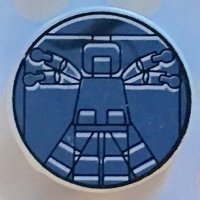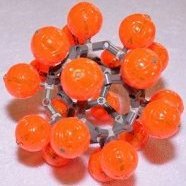Search the Community
Showing results for tags 'servo motor'.
Found 7 results
-

[MOC] Quadruped Robot with Oblique Swivel Joints
camellia posted a topic in LEGO Technic, Mindstorms, Model Team and Scale Modeling
Quadruped Robot with Oblique Swivel Joints + 4 Degrees of Freedom Robot Arm + Oblique Joint + Swivel with Rolling Bearing + 4 Steering Wheel - Spined Quadruped Camellia Nano Controller is not puny. + DC motor + PWM Steering Servo Motor + UART Steering Servo Motor + HMI + LEDs and Pixel + Internet of Things: Access Point and MQTT Footage: Camellia Café - Quadruped Robot with Oblique Swivel Joints -

Pf servo motor 88004 out of production
Variteck posted a topic in LEGO Technic, Mindstorms, Model Team and Scale Modeling
Hi everyone. As you know, the PF servo motor (88004) is out of production and the units left on the market are reaching collector's prices ... Do you know a valid alternative product? I tried with a couple of different Chinese copies of the 88004, but in both cases the steering control is not gradual, but only has 3 positions (all right, center all left). Would it be possible to program a PF motor, like the M motor, with Brickcontroller 2 or similar products, in order to rotate by a defined gradation and then automatically return to zero? I mean in a similar way to what the 42124 does through Control +, which through software transforms a normal motor into a servo motor. -

[MOC] Camellia MCU Laboratory
camellia posted a topic in LEGO Technic, Mindstorms, Model Team and Scale Modeling
Camellia Café MCU (Micro Control Unit) gives children or students initial knowledge of Electronics. In Camellia Café MCU Laboratory, you will get basic knowledge of Electronics, Mechanisms and Software programming. Servo motor is widely used as an actuator of autonomous cars, robots and droids. A Servo Motor is a self-close loop. But only have a high performance motor is not enough. The motor-driven chips, encoder and algorithm play important roles. All keep servo motor with high accuracy in speed / torque, degree / position, time period feedback control. With Wifi Bluetooth/BLE and Cellular, it will be feasible to manipulate them from PCs, Pads and phones. What’s more, this make it easy to connect to Internet and Cloud Database. Mechanism is the body of Autonomous Cars, Robots and Droids. It is the mechanism that fulfills the movement. Gear, Belt or Chain and Linkage are three major transmission mechanisms. This is a simple gear transmission. Due to different teeth of these gears, the speed is reduced with torque increased. Chain or belt is another type movement transmission. It could transmit movement in a long distance. Worm gear is a special gear. It can only transmit from worm to spur. The reverse is infeasible. Linkage is a third type of movement transmission. Crosshead is another key element. However, we are familiar with numbers and letters. Only with Binary, it is hard for a robot to communication with us. It is the ASCII code that instructs a robot to recognize or display letters. Program, or called Code, is the body of the algorithm. It is the program and code that instruct Autonomous Cars, Robots and Droids to perform their action. No matter Assembly Language, or Objective Oriented / Procedure Oriented Language; no matter C, C++, Basic, Java, or Visual C++, C#, even Swift, Python… Don’t worry about so many types of platforms and codes. If you master one of them, you will be familiar with others. When working, you only need to decide which code language is asked as the hardware / platform requires and as your preference, even new type code is coming, after learning in a very short time, you will get that new and get done with your program. Different hardware and different platforms support different code languages. Some hardware such as the controller MCU in Camellia Café Model uses language which is very close to C. Windows support a lot of languages, C, C++, C# and Visual C++ are fittest. Visual Studio is their develop tool. Android (based on Linux) phones and pads use Java. And the develop tool is Android Studio. iOS or Mac OS (based on Unix) which is in your iPhones, iPads or Macs use Objective-C or Swift. Their develop tool is Xcode. Welcome to Camellia Café !-
- mcu
- servo motor
-
(and 4 more)
Tagged with:
-

[MOC] Crab Robotics Car
camellia posted a topic in LEGO Technic, Mindstorms, Model Team and Scale Modeling
Camellia Café presents a special designed Crab Robotics Car model being controlled by Camellia CAPPUCCINO servo motor controller with ARM technology. Each wheel has an individual LEGO motor to drive wheel running speed, distance, time and direction. And each wheel has another individual LEGO servo motor to steer it in a precise angle. Thus 8 LEGO motors are used. Normal: Run forward, backward, or turn Traverse: Run in traverse as a crab with wheels 90 degrees Spin: Spin with wheels 45 degrees Motor: Wheel self-driven motor Motor: Wheel steering motor When turning each wheel in a special degree. It will very easy to turn left or turn right in a short radius. As each wheel has an individual motor to drive it, it is powerful. I think this is a real, real, real four wheel drive car. As each wheel driven motor is a servo motor, it could run in a preset distance. It can run in traverse just like a crab. This is why we name it after crab. Consider all, it is more than a car. It is also a robot. This is why we also name it after robotics. Please drive this Crab Robotics Car. Just make you own robot at home. http://www.camellia.xin/models/crabcar.html -
Greetings. Thanks to herwin's Arduino trains and Lowa's nicely printed track switch motor, I feel Arduino inspired again. I remember I had bought some eBay SG90 servo motors and 3D printed a servo mount at my local public library last year. I dug them out and in 1 - 2 hrs I have it working. I was pleasantly surprised how easy it was to build and code. I reused my Arduino PF train module and code sketch. I connected the servo motor to +/- power and one of the PWM pins. Measured the angles needed for the servo arm to be at to flip the switch. Put the values in the servo.write() function and viola! The pinouts on this servo motor are brown wire is ground, red wire is +5V, and orange is control signal. It can be used with a push button switch to activate instead of fancy Bluetooth devices. That could be useful for public displays where the kids (or adults) can press buttons and watch the train as one half goes one way and the other half tries to go the other way.
-

[HELP] Motors for Steering a Crawler
dtoerien posted a topic in LEGO Technic, Mindstorms, Model Team and Scale Modeling
Hello. I am relatively new to LEGO and very new to Technic. I am particularly interested in the challenges presented by building rock crawlers. My first build was JJ2's 4x4 Super Cralwer V1, which was very rewarding. SevenStuds then kindly directed me to Yoraish's Little Boy Rock Crawler as an instructive build, which it certainly has been. Having just completed it, I have a number of questions that I have not been able to satisfactorily work out for myself and am hoping to benefit from community wisdom. (I am using a rechargeable battery and a V2 IR receiver, along with the original 2 XL motors for driving and the M motor for steering. I am also using very cheap tyres that approximate Pro-Line Flat Iron 1.9" tyres as a test before forking out for the real ones.) I understand, I think, that you might choose to use a M motor (or a L motor?) for steering if (a) you don't have a Servo motor, or (b) have space constraints and/or (c.) require greater torque. Are there any other circumstances where you would use a M or L motor for steering over a Servo motor? I tried using a Servo motor instead of the M motor and it does not turn the wheels at all, although it attempts to. I assume that this means that it does not have enough torque? In Sariel's book, he mentions that the Servo motor has "huge torque" and so "won't be easily stalled" (p. 169). The M motor, however, easily turns the wheels. Does this mean that the M motor has significantly more torque than the Servo motor (Sariel's book doesn't appear to give the torque for the Servo motor, or if it does I missed it) If so, are there any circumstances where you would/could use a Servo motor for steering a crawler and how would you decide this other than trial and error? Yoraish's has the Little Boy doing some pretty extreme crawling (at least it seems so to me) with little difficulty. I find it difficult to tackle a pillow in my lounge without it sounding like something is going to break while steering and have, in fact, managed to pop a wheel off (I experienced the same difficulties with the Super Crawler, which JJ2 kindly helped me to address). I gather that the M motor just keeps turning until you stop (but that unlike the Servo motor does not return to centre when released); this sounds distressing and seems like it could cause actual damage. Is there any way to overcome this? I ask because I and my son - 2 and 1/2 - find it difficult to concentrate on negotiating obstacles due to concerns about damaging something and/or bits popping off. Perhaps it requires greater skill than I/we have at steering? Sorry if I have not asked this particular question well. Many thanks, Darryl and Reuben P.S. I think/hope I have done the images correctly. P.P.S. Any other recommendations for refining this build would also be appreciated (DLuders was very helpful in devloping the initial thread - many thanks). -

Servo Motor - How really useful is it?
DrJB posted a topic in LEGO Technic, Mindstorms, Model Team and Scale Modeling
Not sure I fully understand the usefulness of such motor (relased on crawler/41999). If I wanted motorized steerning, I'd do a small motor + a clutch. The question is then: What does the servo motor really offer, in terms of innovation? or is it simply smaller packaging than M+clutch?

